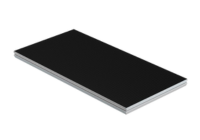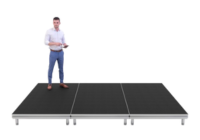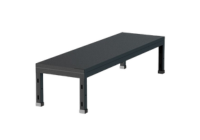Heavy Duty Staging
Live production schedules rarely sit still. Gear arrives, riggers move in, lights go up, artists rehearse, and an audience follows soon after. A dependable foundation makes that constant motion possible. Heavy duty staging delivers precisely that foundation, coupling high load capacity with rigid construction and an uncomplicated assembly process. It is the preferred option whenever a site demands reassurance that neither weather nor weight will compromise performance.
Engineered for Relentless Schedules
Temporary infrastructure often leads a tough life. Repeated load in, load out, cross-country haulage, and fast turnarounds place stress on frames and surfaces alike. A heavy stage is manufactured with this in mind. Steel or reinforced aluminium beams are braced at critical points, then partnered with dense plywood or composite decking. Locking mechanisms connect individual sections firmly enough to eliminate lateral movement while still allowing rapid disassembly. The net result is a platform that shrugs off vibration, point loading, and the odd knock from flight cases.
Performance Advantages at a Glance
- Certified load ratings that exceed typical live production demands
- Integral anti-slip finishes offering reliable foothold in rain or spilt refreshments
- Strong base for rigging inserts and tie-off plates for PA hangs, truss towers, or backdrop frames
- Leg assemblies that accept fine height adjustment to counter uneven ground
- Long service intervals; minimal maintenance between tours or seasons
Safety Detail
Compliance sits front and centre of any structural decision. Load calculations, shear testing, and resistance to imposed dynamic forces are considered at the design stage, not later on-site. Documentation outlining permissible payloads accompanies every platform system, allowing production managers to schedule flown equipment or set pieces confidently. Where necessary, handrail sockets and barrier fittings are pre-installed, ensuring crowd-side edges stay protected without improvisation.
Applications Seen in Practice
While concerts remain the headline act, heavy duty staging supports a broad spectrum of activity:
- Broadcast studio extensions where vibration-free camera tracking is required
- Town-centre celebrations, civic parades, and seasonal light switch-ons
- University graduations, keeping large cohorts at the correct height for visibility
- Film back-lots requiring temporary flooring for cranes, dollies, or green-screen rigs
- Industrial expos showcasing machinery that weighs several tonnes per footprint
Logistics and Handling
High capacity does not forcibly translate into awkward handling. Frames nest together on transport carts; decking stacks to maximise truck space. Colour-coded leg sections identify specific heights quickly during a fast build. Internal brace patterns maintain weight efficiency, so manual handling limits remain reasonable for two-person lifts. The cumulative effect: quicker load-in, tidier storage, and fewer staff hours allocated to basic construction.
Project Workflow for Using a Heavy Stage
Successful staging begins long before the first section is laid down. Site drawings outline desired footprint and height, yet ground conditions often dictate adaption. A brief workflow is typical:
- Site reconnaissance and measurement
- Load calculation based on predicted occupancy and technical gear
- CAD layout outlining module types and bracing strategy
- Installation schedule agreed with other departments—lighting, sound, and set design
- On-site build overseen by competent supervisors
- Handover certification prior to dress rehearsal or audience entry
Economic Considerations
Capital expenditure on heavy-duty staging routinely offsets itself against hire fees for equivalent kit over multiple events. Added resilience means a longer service life before structural refurbishment is required. Spare part support, deck inserts, footpads, clamp sets, extends value further. For organisations running annual festivals or touring circuits, owning a tailored system removes availability concerns and simplifies technical riders year-on-year.
Specification Checklist
When assessing a platform package, planners usually assemble a brief covering:
- Live load rating expressed per square metre
- Deck surface finish—texture, colour, and moisture resistance
- Maximum unsupported span before intermediate legs are required
- Compatibility with existing risers or scenic elements
- Handrail, step, and access-ramp interfacing
- Transport footprint including stillage or dollies
Maintaining Structural Integrity
Regular inspection is straightforward:
- Verify locking pins engage fully without lateral play
- Check leg threads for wear and lubricate lightly where recommended
- Inspect deck surfaces for delamination or deep scoring
- Tighten bolt connections to the torque values supplied in the manual
- Log findings for traceability; schedule repairs promptly if any anomalies emerge
Training and Competence
Even the most reliable hardware depends on capable operators. Introductory courses cover component recognition, safe lifting, sequential build, and strike procedures. More advanced modules dive into load calculations, wind loading on open stages, and integration with flown structures. Documented training not only improves safety; it also streamlines insurance arrangements and complies with workplace legislation.
Future-Proofing Through Adaptability
Touring landscapes evolve: acts grow larger, lighting arrays increase, and audiences expect immersive visuals. A versatile heavy stage absorbs these trends without sending planners back to square one. Additional modules, taller legs, or new surface treatments expand capability rather than replacing entire stock. In short, initial investment remains relevant as technical requirements step forward.



























